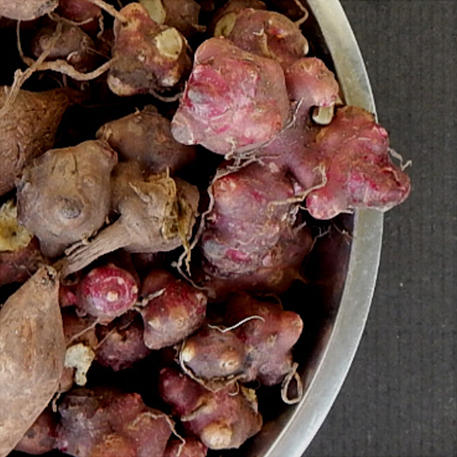-
Filter By Stock
- In Stock (0)
YACON
BOTANICAL NAME: Smallanthus sonchifolius
COMMON NAMES: Peruvian Ground Apple, Groundpear, Pear of the Earth.
FAMILY: Asteraceae
ORIGIN: Heirloom from South America with the Inca name meaning ‘water root’ with its tubers highly valued as a source of refreshment for weary travellers.
PLANT DESCRIPTION
A hardy, attractive herbaceous perennial that yields a large harvest of edible tubers. The tubers have an appealing crunchy crispness that resembles a cross between apple and watermelon, with overtones of sugarcane. The plant can grow to 2.5 metres in height with small, daisy-like yellow flowers. When growing it is similar in appearance to Jerusalem artichokes.
PLANTING GUIDE
The yacon plant produces both rhizomes (reddish looking for propagation) and tubers (large brown elongated bulbs which are great for eating). The edible brown tubers are dried in the sun and then stored in hessian bags. The reddish rhizomes are kept out of the sun and covered with slightly damp sand, sawdust or cocopeat to stop them drying out and put aside for replanting in a dark, dry place. Rhizomes are ready to plant when they begin to sprout.
Prepare the beds by loosening soil well with a fork and working in compost. Place rhizomes into the soil around 50cm apart and cover to a depth of 3cm. Mulch well. Minimal weeding is necessary as dense shade is created as the yacon grows eliminating weeds from establishing. In frost free areas, yacon can be planted all year round. In cooler areas rhizomes are best planted out a couple of weeks before the last frost.
Yacon is able to be planted from Tasmania right up to Queensland.
The plant takes 6 - 7 months to reach maturity. Tubers should be harvested after the flowering top growth dies back. Tubers may also be 'bandicooted' to extend the harvest. As the tubers continue to sweeten while the plant dies back, the main harvest should only take place after all the top growth is dead. The sugar content of the tubers increases upon storage resulting in a sweeter taste. Tubers may also be exposed to the sun for up to 2 weeks to accelerate the sweetening process.
USES
The tubers can be eaten raw, boiled, dehydrated, roasted or processed into beverages, jams, syrup (by boiling down the juice), vinegar, flour, chips and juice. Most commonly eaten raw by removing the outer brown skin and inner white skin by peeling with a knife as the skin has a resinous taste, to reveal the amber coloured sweet crunchy flesh. When juiced the tubers yield a sweet refreshing drink which is high in potassium and electrolytes. The young stem can be used as a cooked vegetable.
The plant's leaves may also be used as a forage crop for animals.
COMPANION PLANTS
Likes: Turmeric, Galangal, Sweet Potato, Cassava, Radish, Beetroot, Bean, Turnip, Pea, Spinach, Zucchini

YACON (Pack of 5 Rhizomes)
***NOT TO WA, TAS*** (Smallanthus sonchifolius sny. Polymnia sonchifolia) Heirloom from South America with the Inca name meaning 'water root' with i
$12.95
